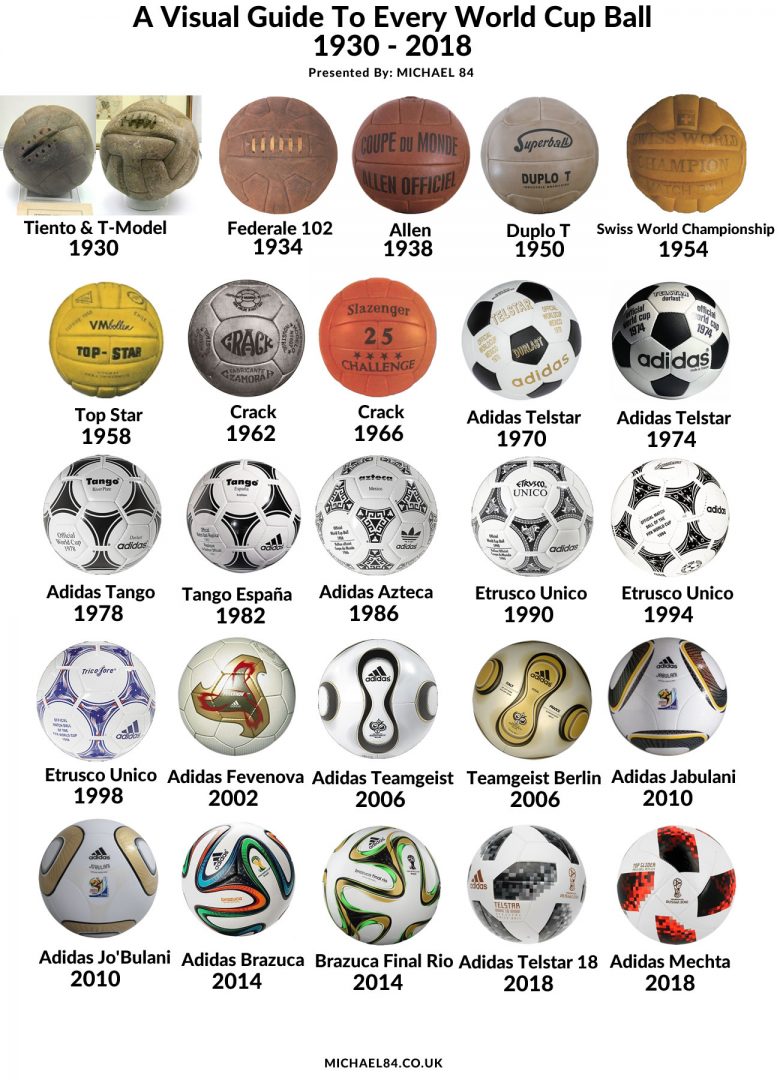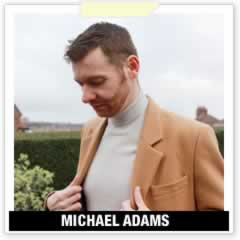
Balls…Footballs. Once they were just round piece of equipment which were absolutely required to play a game of football. But for the past several decades, they’ve became a lot more.
I have always loved the World Cup, and the balls have played a bigger and bigger part in that. I thought it was about time I done a visual guide on all of the balls, and the stories behind them, both in historic terms and my own memories with them.
This is every World Cup football match ball from 1930 to 2018, and some stories behind them.
Footballs have always been at the heart of the game. Whereas some sports required a lot of equipment and other investment, you only need one thing to play football, a ball. This is why the game is so popular all over the world. Virtually anyone can play it.
As the commercial and business aspect came into the game, the balls became a bigger part. There’s been differences in the technical aspects of the balls, which have played a huge part in the game. However the biggest impact for fans has probably been the designs, which is mostly what I will be talking about.
First of all, here’s the list of all the World Cups, and the balls that were used.
Every World Cup Ball
- 1930 – Tiento (first half) & T-model (second half)
- 1934 – Federale 102
- 1938 – Allen
- 1950 – Duplo T
- 1954 – Swiss World Champion
- 1958 – Top Star
- 1962 – Crack
- 1966 – Slazenger Challenge 4-Star
- 1970 – Adidas Telstar
- 1974 – Adidas Telstar Durlast
- 1978 – Adidas Tango
- 1982 – Adidas Tango España
- 1986 – Adidas Azteca
- 1990 – Adidas Etrusco Unico
- 1994 – Adidas Questra
- 1998 – Adidas Tricolor
- 2002 – Adidas Fevernova
- 2006 – Adidas Teamgeist (Teamgeist Berlin for the final)
- 2010 – Adidas Jabulani (Jobulani For the final)
- 2014 – Adidas Brazuca (Brazuca Final Rio for the final)
- 2018 – Adidas Telstar 18 & Metcha
There’s a lot of cool history behind the footballs.

In 1930, the World Cup was hosted in Uruguay, and they used 2 balls in the final, one for each half. The final was between hosts Uruguay and Argentina. The Tiento was supplied by Argentina for the 1st half, and had a 2-1 lead.
The T-Model was supplied by Uruguay, and was a larger and heavier ball. They ended up winning 4-2, turning the game on it’s head.
In 1950 the Duplo-T, which was supplied by Superball, was the first ball to have no laces and a syringe valve.
The 1954 ball called Swiss World Champion supplied by Swiss hosts Kost Sport was the first 18 panel ball.
Most will have seen the 1966 World Cup ball, mostly because it was the year that England won the World Cup. We’ve all seen that it was orange, but did you know that it was made by Slazenger? Well, it was!
When we got to 1970, that’s when the fun started with the balls, and when they really took hold in terms of commercial appeal. This was the first World Cup ball for Adidas, who came with their Telstar ball. The first 32 panel ball.
In 1974 Adidas came back with their Telstar, this time called Telstar Durlast, and had a PU coating, which made it waterproof and more resistant to wear and tear.

1978 would mark the start of a generation of footballs for Adidas. It was the first of the Adidas Tango balls, perhaps the most infamous design of them all.
The Tango España followed in 1982 for the World Cup in Spain, which was the last leather football to be used in a World Cup.
In 1986 it was replaced with a similar design, the Azteca, a nod to hosts Mexico. It was the first fully synthetic ball.
1990 and 1994 once again saw similar designs to the Tango, in the Etrusco Unico and Questra . Just like the Azteca before it, they incorporated inspiration from each host for the designs.
1998 was the first ball with some colour, with the Tricolor ball for France 98.
2002 was a memorable design for me, with a triangular type of pattern. This was the Fevernova, used in the Korea/Japan 2002 World Cup.
In Germany 2006, a very new looking ball came around. It was technically different, it was a 14 panel ball. 2006 was also the first time that they made a special ball just for the final, which was technically the same but had a different, gold design.
2010 The ball, the Jabulani had 8 panels, and the 2014 and 2018 balls had 6 panels. The Russia 2018 ball was named Telstar 18, paying homage to the first Adidas World Cup ball.
The Commercialisation And Over Commercialisation Of The Balls
The commercial aspect of the footballs has been a good thing, but has it gone too far?
The commercial engine has run the same for footballs as most other things. Here’s what’s happened:
Imagine a time where you had to just buy any old regular football, that’s not bad. But then comes the time where you can buy the one you’ve seen on TV! That’s cool, the feeling you get as a kid to play with the same ball as you’ve seen on TV is great.
The ball was not just a ball anymore. It was all about selling the tournament. A great touch was incorporating tradition and flavour from the hosts, first seen in the 1986 World Cup with the Azteca ball.
This is great for commercial revenue, and great for fans. But then it starts to goes up a notch…
In the 90’s you can buy a replica ball. It looks the same, almost identical. However as the balls evolved, they’ve got more expensive, and there’s two options. There’s the replica, or the authentic match ball.
These are much more expensive, in fact 5x or 6x more expensive. But you can still buy the replica, so that’s cool.

Fast forward to 2006. Now there’s not one match ball, there’s two. There’s one for most games, but a special ball for the final. So now you can get the replica of the main match ball, but if you want the one they used in the final, you’re going to have to buy another one too.
In 2018 it was a similar story, 2 different balls, with one for the group stages, and another for the rest of the tournament.
Are we seeing an over-commercialised of the footballs? I think it takes something away from the magic of the design. We all remember the ball used in various World Cups, because there was only one of them.
If it continues down this road, we might end up seeing 4 or 5 different balls for all the different stages of the World Cup.
I think they should just keep with one ball design. It gives the tournament that extra bit of special feeling it deserves.
Rounder Balls & Controversies
One of the controversies I can remember in recent memory was the balls being advertised to football fans and players alike was that they were “rounder”. This seemed to be a common theme for years.
This all escalated around the Jabulani ball used in 2010, where players complained about the aerodynamics and flight of the ball, leaving many goalkeepers looking red faced.
What Is The Most Famous World Cup Ball Design?
The most famous World Cup ball design for me has to be the Tango.
I actually bought a replica several years back, it was an Adidas Tango Pasedena, and I love it. The design was widely used and slightly adapted or changed for around 20 years, and made it’s way into the European Championships too.
If you watched any international football in the late 70s, 80s or 90s, you’ve probably seen an Adidas Tango or a design based on it.
Subbuteo was very big around the time too, and I remember having lots of little Tango balls in many Subbuteo sets.
My Favourite Ball? A Tough Choice
When it comes to picking one favourite, I can’t. But I can pick out 3. These are: the Tango, the Tricolor and the Jabulani.
First off I have to talk about the Tricolor. It was France 98, so I was 13-14 years old. It seemed quite expensive, especially for you and your mates to kick around and it end up in someone’s garden or otherwise lost.
Anyway I did get one, as soon as they came out, it was £9.99. You could probably buy 2 or 3 random crappy balls for the same price back then, so it felt expensive. I used it a little bit, but it kind of felt like letting your mates and random kids who’d play football with you kick around your money.
I have no idea what happened to the ball in the end, I guess I threw it out, but I know that I didn’t over use it, or “pop” it.
The Tango I have already mentioned. It’s just an iconic ball. I never owned one when they were being used, because I wasn’t alive for most of the time they were official match balls. However, I did see them a lot on TV growing up, and when I’ve watched lots of retro football, I’ve seen them a lot over the years as an adult too.
So several years ago I bought the Adidas Pasedena, and love it. I kick it around every now and then, which is probably a mistake – They’re going on eBay for £50 or so!
The Jabulani…It was the 2010 World Cup hosted in South Africa. There was all the controversy with the ball as already mentioned, but it will always be a great ball to me. Spain won the World Cup in 2010, so the ball will always be remembered fondly by myself.
It was actually the Jo’Bulani that was used in the final, the same ball with a different design.
And there you have it, my visual guide on all the footballs used in every World Cup.
Was there a ball which stood out for you? Did you have a favourite and do you own any of the World Cup balls?
A note for the future me and yourself, if you like footballs, buy official balls when they’re released! It turns out they can be worth a lot of money! 😉








